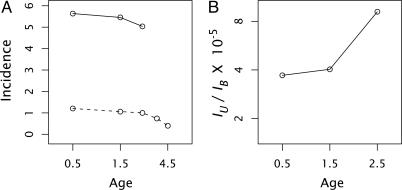Fig. 3.
Age-specific incidence of retinoblastoma. (A) Bilateral (solid line) and unilateral (dashed line) cases of retinoblastoma per 106 population, shown on a log10 scale. (B) Ratio of unilateral (IU) to bilateral (IB) incidence at each age by using the data in A. For the inherited form, I used 221 reported bilateral cases taken directly from the SEER database (http://seer.cancer.gov) for 1973–2001. To estimate age-specific incidence, I assumed that 65% of carriers eventually developed bilateral tumors based on the estimated penetrance for bilateral retinoblastoma given by Knudson (3). The incidence in each year is approximately the fraction of cases in that year divided by the fraction of individuals who had not developed the disease in earlier years. For the sporadic form, I used the reported incidence of unilateral cases in Young et al. (16), which is also from the SEER database. However, the SEER data do not differentiate between sporadic and hereditary unilateral cases. Based on data from Knudson (3), ≈75% of unilateral cases are sporadic cancers and ≈25% arise from carriers who inherit a mutation.

